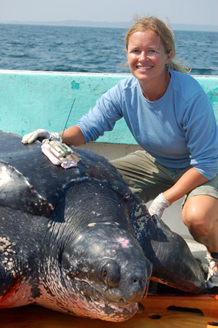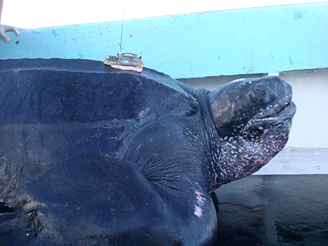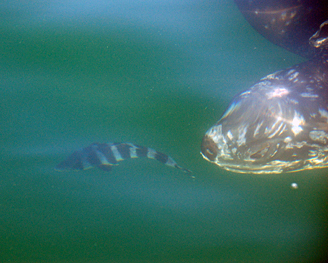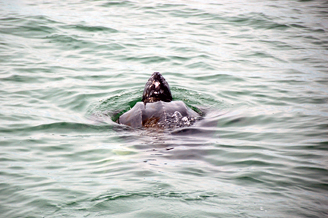RESEARCH
LEATHERBACK TURTLES (Dermochelys coriacea)
Background

Kara Dodge leads LPRC’s leatherback turtle research as part of her Ph.D. work. (Photo credit: Nuno Fragoso. Research conducted under NMFS Permit 1557-03.)
Leatherback sea turtles are considered an endangered species worldwide, and some populations have undergone a precipitous decline over the last two decades. Leatherbacks have a unique, warm-bodied physiology and a different type of carapace than “hard shelled” sea turtles. They’re fast growing and deep diving, and subsist primarily on gelatinous prey, suggesting that their unusual diets and energy sources play an important role in the species’ highly migratory life style and ecology.
Despite decades of research, many questions remain about Atlantic leatherback migration patterns, distribution, habitat use, foraging ecology, physiology, population structure, and health. The LPRC is currently conducting in-water research on male, female, and juvenile leatherbacks in the northwest Atlantic, with a particular focus on localized movements, migratory patterns, habitat use and foraging ecology. Through collaboration with other institutions, we’re also investigating leatherback distribution, health, population structure, and by-catch in fixed gear fisheries.
Migration and Habitat Use

Male leatherback turtle "Ian" with GPS-linked satellite tag takes a breath before release. (Photo credit: Kara Dodge. Research conducted under NMFS Permit 1557-03.)
Since 2007, LPRC researchers have been using GPS-linked satellite tags to track leatherbacks and learn more about their dive behavior and habitat use. To date, we have followed and received data from 22 leatherback turtles initially tagged and tracked off Cape Cod, MA and off the northern Florida coast, two important foraging grounds. From tagging data, we can identify what ocean habitats leatherbacks use most, how they get there and back, and where and when they breed and over-winter. With tagging, we can also evaluate the effects of oceanographic conditions such as sea surface temperature and chlorophyll-a (a proxy for primary production) on leatherback movements, and what cues leatherbacks may use for orientation and navigation during long distance migrations.
Foraging ecology

Leatherback turtle "Ethan" and pilot fish, Nantucket Sound, July 2009. (Photo credit: Kara Dodge)
Understanding the leatherback’s forage base will be necessary for predicting potential impacts of oceanographic and climatic shifts on their populations, yet these turtles spend most of their lives submerged and on the high seas, where their feeding habits are difficult to observe. From the seminal historic work conducted by Dr. Sherman Bleakney and Skip Lazell, the New England continental shelf has long been known as a seasonal forage grounds for leatherbacks. Nonetheless, only a few diet studies have been performed, and they relied on stomach content analysis, which has limited utility for identifying gelatinous and rapidly digested prey. LPRC researchers analyze carbon and nitrogen stable isotopes in leatherback tissues and prey to improve our understanding of the leatherback’s diet and energy sources. Isotope analyses are particularly helpful for discerning diet for periods of time when animals can’t be observed, and for detecting prey that are rapidly digested. Our results are consistent with historic studies highlighting a diet of scyphozoan or “jellyfish” prey, but also reveal the importance of ctenophores or “comb jellies” as a food source for leatherbacks. Our findings also offer new insight on size- and sex-related differences in the diet of leatherbacks northwest Atlantic shelf.
Health and Population Studies

Leatherback turtle taking a breath at the surface. (Photo credit: Kara Dodge)
Health threats to all sea turtle species are poorly understood, and this is especially true for leatherback turtles, that are rarely successfully kept in long-term captivity where they can be studied. Since 2007, LPRC researchers have collaborated with veterinary specialists from the New England Aquarium and the Provincetown Center for Coastal Studies to conduct health evaluations of leatherback sea turtles in order to better understand their baseline health, physiology, and pathology off Massachusetts. Results from work conducted from 2007 – 2009 have been reported by Innis et al., in the journal Chelonian Conservation and Biology (see 9:205-222). Since 2006, the LPRC has also been collecting DNA samples from leatherback turtles for genetic analysis in order to contribute to a better understanding of their population structure in the Atlantic.
Related Links
Leatherback Turtle
- Seaturtle.org
- Canadian Sea Turtle Network
- Irish Sea Leatherback Turtle Project
- The Archie Carr Center for Sea Turtle Research
- The Anatomy of Sea Turtles
- IUCN Marine Turtle Specialist Group
- Turtle Research at the University of Wales, Swansea
- NOAA Fisheries, Office of Protected Resources
- The Scyphonzoan – Jellyfish information
